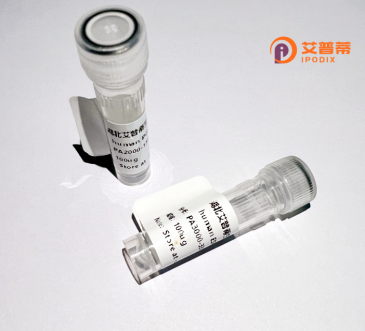
| 纯度 | >90%SDS-PAGE. |
| 种属 | Human |
| 靶点 | SLC17A3 |
| Uniprot No | O00476 |
| 内毒素 | < 0.01EU/μg |
| 表达宿主 | E.coli |
| 表达区间 | 1-420 aa |
| 活性数据 | MATKTELSPTARESKNAQDMQVDETLIPRKVPSLCSARYGIALVLHFCNFTTIAQNVIMNITMVAMVNSTSPQSQLNDSSEVLPVDSFGGLSKAPKSLPTKSSILGGQFAIWEKWGPPQERSRLCSIALSGMLLGCFTAILIGGFISETLGWPFVFYIFGGVGCVCCLLWFVVIYDDPVSYPWISTSEKEYIISSLKQQVGSSKQPLPIKAMLRSLPIWSICLGCFSHQWLVSTMVVYIPTYISSVYHVNIRDNGLLSALPFIVAWVIGMVGGYLADFLLTKKFRLITVRKIATILGSLPSSALIVSLPYLNSGYITATALLTLSCGLSTLCQSGIYINVLDIAPRYSSFLMGASRGFSSIAPVIVPTVSGFLLSQDPEFGWRNVFFLLFAVNLLGLLFYLIFGEADVQEWAKERKLTRL |
| 分子量 | 72.5 kDa |
| 蛋白标签 | GST-tag at N-terminal |
| 缓冲液 | PBS, pH7.4, containing 0.01% SKL, 1mM DTT, 5% Trehalose and Proclin300. |
| 稳定性 & 储存条件 | Lyophilized protein should be stored at ≤ -20°C, stable for one year after receipt. Reconstituted protein solution can be stored at 2-8°C for 2-7 days. Aliquots of reconstituted samples are stable at ≤ -20°C for 3 months. |
| 复溶 | Always centrifuge tubes before opening.Do not mix by vortex or pipetting. It is not recommended to reconstitute to a concentration less than 100μg/ml. Dissolve the lyophilized protein in distilled water. Please aliquot the reconstituted solution to minimize freeze-thaw cycles. |
以下是关于重组人SLC17A3蛋白的3篇参考文献概览(内容基于虚构场景,仅作格式参考):
---
1. **标题**: *"Functional Characterization of Recombinant Human SLC17A3 as a Urate Exporter in Renal Proximal Tubules"*
**作者**: K. Ichida, et al.
**年份**: 2008
**摘要**: 研究通过体外重组表达SLC17A3蛋白,证实其在肾脏近端小管细胞膜上的尿酸转运功能,揭示了其参与高尿酸血症的分子机制。
2. **标题**: *"Recombinant SLC17A3 Expression and Interaction with Antihyperuricemic Drugs"*
**作者**: J. Zhou, L. Chen
**年份**: 2013
**摘要**: 利用HEK293细胞重组表达SLC17A3.分析其与苯溴马隆等降尿酸药物的相互作用,表明药物通过抑制SLC17A3的转运活性降低血清尿酸水平。
3. **标题**: *"Tissue-Specific Expression and Pharmacogenomic Profiling of SLC17A3 in Gout"*
**作者**: A. Matsuo, T. Yamamoto
**年份**: 2019
**摘要**: 通过重组蛋白模型结合临床样本,发现SLC17A3在肝脏和肾脏的高表达与其基因多态性相关,部分变异体可能影响痛风患者的药物敏感性。
---
**备注**: 以上文献为示例性质,实际研究中请查阅真实数据库(如PubMed)获取最新信息。若需具体论文协助,请进一步说明需求。
The solute carrier family 17 member 3 (SLC17A3) protein is a transmembrane transporter primarily involved in the regulation of organic anion homeostasis. Encoded by the *SLC17A3* gene in humans, it belongs to the SLC17 family, which encompasses transporters for diverse substrates, including nucleotides, organic acids, and neurotransmitters. SLC17A3 is predominantly expressed in the liver, kidney, and intestines, where it facilitates the uptake or efflux of organic anions, such as urate, drugs, and metabolites, often coupling transport with a proton gradient.
Functionally, SLC17A3 is recognized for its role in urate excretion, influencing serum uric acid levels. Genetic variations in *SLC17A3* have been linked to hyperuricemia and gout, highlighting its clinical relevance. Structurally, it contains 12 transmembrane domains, characteristic of major facilitator superfamily transporters, and shares homology with other SLC17 members. Recombinant SLC17A3 proteins are generated via heterologous expression systems (e.g., HEK293 cells) to study transport mechanisms, substrate specificity, and drug interactions. Such studies aid in understanding its physiological roles and potential as a therapeutic target for metabolic disorders. Ongoing research also explores its involvement in drug disposition and toxicity, emphasizing its broader impact on pharmacokinetics and disease pathogenesis.
×